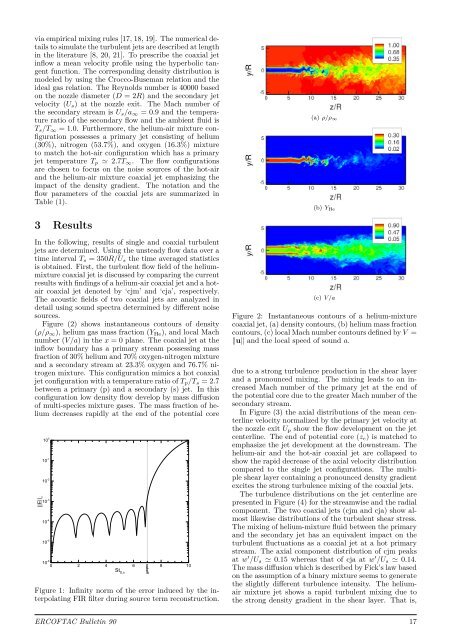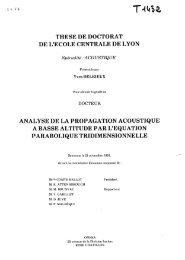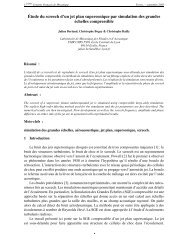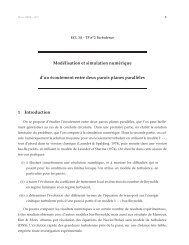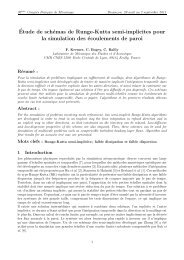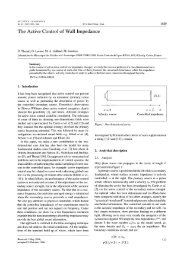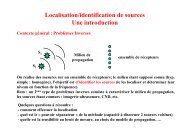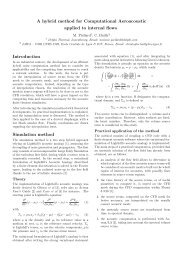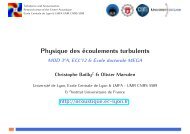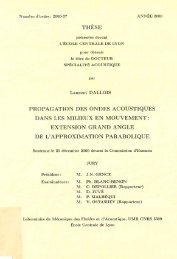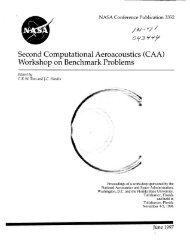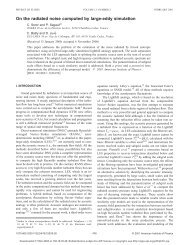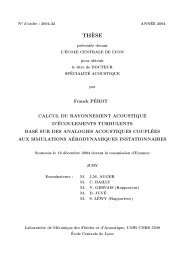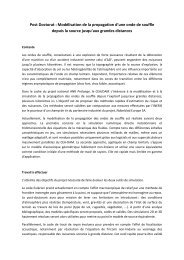ERCOFTAC Bulletin - Centre Acoustique
ERCOFTAC Bulletin - Centre Acoustique
ERCOFTAC Bulletin - Centre Acoustique
You also want an ePaper? Increase the reach of your titles
YUMPU automatically turns print PDFs into web optimized ePapers that Google loves.
via empirical mixing rules [17, 18, 19]. The numerical details<br />
to simulate the turbulent jets are described at length<br />
in the literature [8, 20, 21]. To prescribe the coaxial jet<br />
inflow a mean velocity profile using the hyperbolic tangent<br />
function. The corresponding density distribution is<br />
modeled by using the Crocco-Buseman relation and the<br />
ideal gas relation. The Reynolds number is 40000 based<br />
on the nozzle diameter (D = 2R) and the secondary jet<br />
velocity (Us) at the nozzle exit. The Mach number of<br />
the secondary stream is Us/a∞ = 0.9 and the temperature<br />
ratio of the secondary flow and the ambient fluid is<br />
Ts/T∞ = 1.0. Furthermore, the helium-air mixture configuration<br />
possesses a primary jet consisting of helium<br />
(30%), nitrogen (53.7%), and oxygen (16.3%) mixture<br />
to match the hot-air configuration which has a primary<br />
jet temperature Tp ≃ 2.7T∞. The flow configurations<br />
are chosen to focus on the noise sources of the hot-air<br />
and the helium-air mixture coaxial jet emphasizing the<br />
impact of the density gradient. The notation and the<br />
flow parameters of the coaxial jets are summarized in<br />
Table (1).<br />
3 Results<br />
In the following, results of single and coaxial turbulent<br />
jets are determined. Using the unsteady flow data over a<br />
time interval Ts = 350R/Us the time averaged statistics<br />
is obtained. First, the turbulent flow field of the heliummixture<br />
coaxial jet is discussed by comparing the current<br />
results with findings of a helium-air coaxial jet and a hotair<br />
coaxial jet denoted by ‘cjm’ and ‘cja’, respectively.<br />
The acoustic fields of two coaxial jets are analyzed in<br />
detail using sound spectra determined by different noise<br />
sources.<br />
Figure (2) shows instantaneous contours of density<br />
(ρ/ρ∞), helium gas mass fraction (YHe), and local Mach<br />
number (V/a) in the x = 0 plane. The coaxial jet at the<br />
inflow boundary has a primary stream possessing mass<br />
fraction of 30% helium and 70% oxygen-nitrogen mixture<br />
and a secondary stream at 23.3% oxygen and 76.7% nitrogen<br />
mixture. This configuration mimics a hot coaxial<br />
jet configuration with a temperature ratio of Tp/Ts = 2.7<br />
between a primary (p) and a secondary (s) jet. In this<br />
configuration low density flow develop by mass diffusion<br />
of multi-species mixture gases. The mass fraction of helium<br />
decreases rapidly at the end of the potential core<br />
||E|| ∞<br />
10 0<br />
10 -1<br />
10 -2<br />
10 -3<br />
10 -4<br />
10 -5<br />
10<br />
0 2 4 6 8 10<br />
StD,s -6<br />
Figure 1: Infinity norm of the error induced by the interpolating<br />
FIR filter during source term reconstruction.<br />
cutoff<br />
(a) ρ/ρ∞<br />
(b) YHe<br />
(c) V/a<br />
Figure 2: Instantaneous contours of a helium-mixture<br />
coaxial jet, (a) density contours, (b) helium mass fraction<br />
contours, (c) local Mach number contours defined by V =<br />
u and the local speed of sound a.<br />
due to a strong turbulence production in the shear layer<br />
and a pronounced mixing. The mixing leads to an increased<br />
Mach number of the primary jet at the end of<br />
the potential core due to the greater Mach number of the<br />
secondary stream.<br />
In Figure (3) the axial distributions of the mean centerline<br />
velocity normalized by the primary jet velocity at<br />
the nozzle exit Up show the flow development on the jet<br />
centerline. The end of potential core (ze) is matched to<br />
emphasize the jet development at the downstream. The<br />
helium-air and the hot-air coaxial jet are collapsed to<br />
show the rapid decrease of the axial velocity distribution<br />
compared to the single jet configurations. The multiple<br />
shear layer containing a pronounced density gradient<br />
excites the strong turbulence mixing of the coaxial jets.<br />
The turbulence distributions on the jet centerline are<br />
presented in Figure (4) for the streamwise and the radial<br />
component. The two coaxial jets (cjm and cja) show almost<br />
likewise distributions of the turbulent shear stress.<br />
The mixing of helium-mixture fluid between the primary<br />
and the secondary jet has an equivalent impact on the<br />
turbulent fluctuations as a coaxial jet at a hot primary<br />
stream. The axial component distribution of cjm peaks<br />
at w ′ /Us ≃ 0.15 whereas that of cja at w ′ /Us ≃ 0.14.<br />
The mass diffusion which is described by Fick’s law based<br />
on the assumption of a binary mixture seems to generate<br />
the slightly different turbulence intensity. The heliumair<br />
mixture jet shows a rapid turbulent mixing due to<br />
the strong density gradient in the shear layer. That is,<br />
<strong>ERCOFTAC</strong> <strong>Bulletin</strong> 90 17


